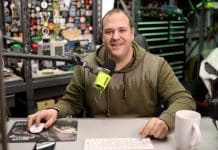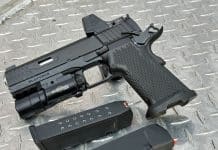In this fourth installment of “Loading for the Semi-Precision Rifle,” Aaron takes us through the steps of performing a Ladder Test.

Long long ago we started this series on reloading for the semi-precision rifle. Semi-precision meaning “not a bench gun.” Up until this point we went over the basic things to consider when building your first load. Now we’re going to shoot what’s called a ladder test.
There are a ton of opinions out there about the best way to get to the perfect round for your rifle, and this is just one. It works well for me, even though there are likely better ways. This is the best way I know, however if you know a better way, chime up. That’s what the comment section is for.
Also read:
Part I: Cooking Up Some Loads For The Semi-Prescision Rifle Shooter
Part II: The Equipment To Load
Part III: Loading For The Semi Precision Rifle
Part IV: Performing The Ladder Test
The point of a ladder test is to fire a series of charges, each one hotter than the last. This gradual increase in the size of explosion contained in your weapon will naturally cause your bullets to rise or fall on paper due to a combination of speed and vibration of your barrel. What we want is to find the point where the muzzle of the rifle’s barrel reaches its highest point in that vibration. This is called the antinode. The point where the barrel reaches its lowest point in the vibration is also called an antinode, but if we can get the bullet to leave the barrel when its at its highest, we’ll have more room to elevate the optic later for extreme long shots.
When you pull the trigger causing a small explosion, your barrel acts like a guitar string. There are various stages of this harmonic wave, but a barrel will stay at the antinode slightly longer because it has to stop and go the other direction. Its kind of like a clay bird being thrown. When that bird hits its high point, it more or less stays there for a split second before changing direction. Often times, that’s the easiest time to hit one because its moving its slowest. The idea here is this: if we can tailor our custom load to leave the barrel at this point in the harmonic wave, even if our weight is a little off, the projectile may still leave the barrel close to the antinode, and since the barrel is moving slower the impacts may still be close. We’ll see this in the test. We’re looking for a collection of impacts that seem to group together, then they’ll spread apart again as the barrel moves from the antinode to the node (the middle of the harmonic wave when its moving the fastest).
Keep in mind the heaviest charge you load needs to stay well into the safe range for your gun. If you start seeing pressure signs, STOP! The last thing you want is a bolt blown into your teeth.
So now we have our collection of loaded cartridges. We started at a low charge of 35.5 grains of IMR 4064, and moved up to 42.5 grains in .5 grain increments. Each round is labeled with numbers designating the charge held within. If for some reason these things spill all over the ground, we can still use them. If they aren’t labeled, you might as well go pull the projectiles, re-charge and re-seat. That’s a lot of work we don’t want to screw with, so my advice is to label each round. Now, off to the range.
The Range
We’re going to shoot these test rounds at 300 yards. We need the distance to provide some spread. Its highly likely that even with the large variation in powder we’d have our impacts spaced very closely together at 100 yards. When that happens, we can’t distinguish our node/antinode points as easily, so 300 yards it is.
After firing each round we’ll record the velocity and move downrange to mark it. I’ve loaded up two sets of the same series of charges. Each one will be sent to a different target. I do this in the name of consistency. If target two reflects a similar shot pattern to target one, I know the data I’m collecting here is valid.
The Results
After throwing 30 rounds down range (two sets of our ladder test), we’ve got two targets to look at and compare with our speed data gathered with the chronograph.

Before we get started with locating the antinode, I noticed two things while conducting this test I found interesting. A – More powder doesn’t mean more speed, and B – More speed doesn’t mean higher impact. Check out the gradual drop in speed from start until about 38.5 grains. From there it continues to climb. Maybe someone reading this can chime in and explain why this is. Also note the consistent drop in impact of our fastest round, 42.5. Even though it left the barrel over 200 feet per second faster than 39.5 grains, it still impacted the target several inches lower.
Note the impacts starting at 35.5 grains. They gradually increased in height. It should be mentioned that at 36.5 grains on target two I moved my windage .5 mil to the left. This doesn’t matter, because what we’re looking for here is a consistency on the vertical axis.
Whatever, lets find the antinode.
The rounds all climbed higher and higher on the target until about 39.5 grains. See the group between 39.5 and 41.5 grains? We found our antinode. Its still a fairly light load for the .308, so its possible we could get to the next high antinode in the harmonic wave before pressure signs, but we’ll save that for later.

Here’s the beauty of developing a load with this type of data. If our chosen charge of 4064 was 41 grains, we could be off nearly a grain in either direction and still have consistency at the target. Can we do better? Sure we can. We can create a second ladder test starting at 39.5 grains of 4064 and moving up to 42 grains in .2 grain increments. But, to make this work, we need to stretch it out even further. To see visible changes in elevation, we need to go to 500 or even 600 yards….maybe further. But, this is all dependent on someone’s shooting ability as well.
As for me, I’m going to stop here and spend more time shooting. I need the practice more than the perfect round.
* The views and opinions expressed on this web site are solely those of the original authors and contributors. These views and opinions do not necessarily represent those of Guns & Tactics Magazine, the administrative staff, and/or any/all contributors to this site.













[…] Part IV: Performing The Ladder Test […]
[…] Part IV: Performing The Ladder Test […]
[…] Part I: Cooking Up Some Loads For The Semi-Prescision Rifle Shooter Part II: The Equipment To Load Part III: Loading For The Semi Precision Rifle Part IV: Performing The Ladder Test […]
Great idea!
To do this with a little less leg work, I shoot a cardboard backer, white side facing me. I color each bullet with a different color sharpie before firing and record which loads were which colors. Shoot all my rounds, THEN go down range. Take a bottle of alcohol and a Q-tip. Wet each bullet hole and the color will bleed from the hole into the white paper identifying which bullets made which holes.
I’ve used ladder testing to optimize my load for my FN SPR and it runs beautifully as a result. VERY consistent.
Comments are closed.